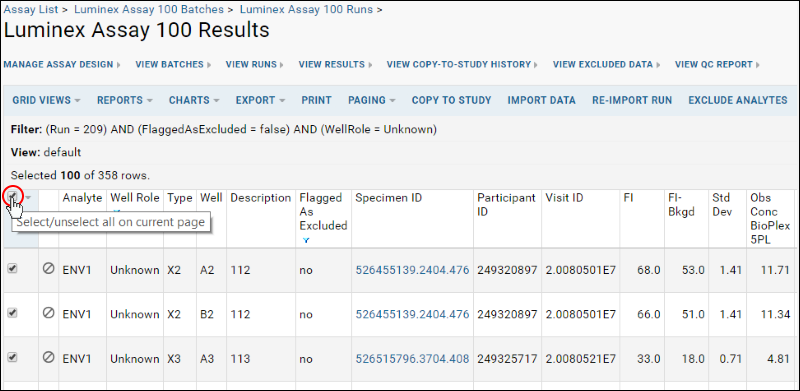Copying assay data to a study allows you to integrate it with other types of data from other sources. If you are only interested in exploring non-integrated wish, you can skip this step and proceed to the next Luminex tutorial:
Luminex Assay Tutorial Level II.
In the steps below, we move selected, quality-controlled Luminex assay data into a LabKey
study. In this example, we select only data associated with unknowns, and only data that have not been excluded as part of the QC process.
In order to integrate assay data with other types of data in a LabKey study, you need to connect the instrument data to participants or specimen samples in some way. This step shows you how to link the sample identifiers in your instrument data with specimen vial identifiers in the target study. The links are provided in a mapping file that associates the sample identifiers (in the
Description column, e.g., "111", "112", "113") with specimen vial identifiers in the target study (e.g., "87443202.2604.480"). If you do not provide a mapping file, you would need to manually enter the participant identifier and visit data for each row of data.
Install a Target Study
You need a target study for your assay data, so this step creates one based on the LabKey Demo Study.
Re-Import a Run
Next we re-import a run, this time indicating a target study and a mapping file for the data.
- Return to the Assay Dashboard of your Luminex folder.
- In the Assay List, click Luminex Assay 100.
- On the Luminex Assay 100 Runs list, place a checkmark next to 02-14A22-IgA-Biotin.xls (the original single run we imported).
- Click Re-Import Run.
- Under Batch Properties enter the following:
- Participant/Visit:
- Click the checkbox Sample indices, which map to values in a different data source.
- In the LuminexSample data you downloaded and unzipped, open the Excel file /Luminex/Runs - Assay 100/IndexMap.xls.
- Copy and paste the entire contents of this file (including all column headers and non-blank rows) to the text box under Paste a sample list as a TSV.
- Target Study:
- Select the target study you installed above, by default: /home/HIV-CD4 Study (Interactive Example - Study).
- Click Next.
- On the page Data Import: Run Properties and Data File, scroll down and click Next.
- On the page Data Import: Analyte Properties you may see a warning about previous exclusions; leave the "Retain matched exclusions" checkbox checked if so.
- Scroll down and click Save and Finish.
Select a Subset of Data to Copy
We wish to exclude standards, controls and background wells when we copy. We also want to exclude data that was flagged and excluded as part of the QC process.
- On the page Luminex Assay 100 Runs click 02-14A22-IgA-Biotin.xls (reimporting made it the first row).
- Filter the results to show only wells with unknowns (vs standards or controls):
- Click on Well Role column header and select Filter.
- In the popup, select Unknown by clicking its label, and click OK.
- Notice that your data grid now includes values in the Specimen ID, Participant ID, and visitID columns which were not present before we added the mapping during the reimport.
- Filter the results to show only wells with non-excluded data:
- Click on Flagged As Excluded column header and select Filter.
- In the popup, select only false and click OK.
- Select all displayed rows on the current page of the grid using the checkbox at the top of the left column.
- Hover over the "Selected 100 of 350 rows." to display additional options.
- Click SELECT ALL 350 ROWS to select all 350 row in the table
- Click SELECT NONE to de-select the rows

Copy Selected Data to the Study
- Click Copy to Study.
- Note that we have pre-selected our target study: Interactive Example - Study in folder /home/HIV-CD4 Study. The checkbox to "Copy to a different study" is available but unnecessary in this tutorial.
- Click Next.
- The specimen data has been successfully matched to participants/visits in the demo study via specimen IDs. You will see green markers next to each row of data that has been successfully matched, as shown in the screen shot below.
- On the page, Copy to...Study: Verify Results, finalize the copy by clicking Copy To Study.

If you see the error message 'You must specify a Participant ID (or Date) for all rows.' it means there are unmatched rows. Scroll down to unselect them, then click
Copy To Study again.
When the copy is complete, you will be in the target study viewing the copied dataset. If other data from Luminex Assay 100 has already been copied to the study, the new dataset may be shown as Luminex Assay 1001 or something similar.
View the Copied Data in the Study
- To see the dataset you copied to the study, click the Clinical and Assay Data tab.
- Scroll down to the "Uncategorized" section to find your copied Luminex dataset on the list. Use the pencil icon on the data views webpart to recategorize the dataset, or simply click to view the copied data again.
You can also see a similar copied assay dataset displayed in the interactive example study, shown
here.
